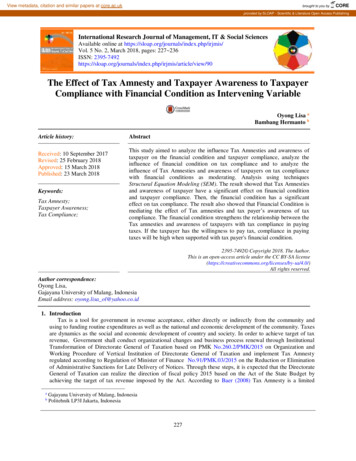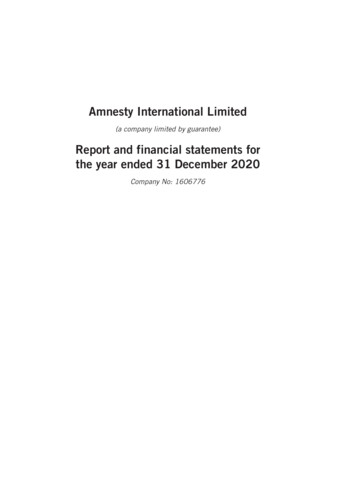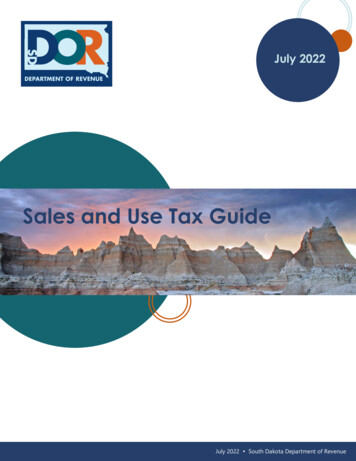
Transcription
View metadata, citation and similar papers at core.ac.ukbrought to you byCOREprovided by SLOAP - Scientific & Literature Open Access PublishingInternational Research Journal of Management, IT & Social SciencesAvailable online at https://sloap.org/journals/index.php/irjmis/Vol. 5 No. 2, March 2018, pages: 227 236ISSN: is/article/view/90The Effect of Tax Amnesty and Taxpayer Awareness to TaxpayerCompliance with Financial Condition as Intervening VariableOyong Lisa aBambang Hermanto bArticle history:Received: 10 September 2017Revised: 25 February 2018Approved: 15 March 2018Published: 23 March 2018Keywords:Tax Amnesty;Taxpayer Awareness;Tax Compliance;AbstractThis study aimed to analyze the influence Tax Amnesties and awareness oftaxpayer on the financial condition and taxpayer compliance, analyze theinfluence of financial condition on tax compliance and to analyze theinfluence of Tax Amnesties and awareness of taxpayers on tax compliancewith financial conditions as moderating. Analysis using techniquesStructural Equation Modeling (SEM). The result showed that Tax Amnestiesand awareness of taxpayer have a significant effect on financial conditionand taxpayer compliance. Then, the financial condition has a significanteffect on tax compliance. The result also showed that Financial Condition ismediating the effect of Tax amnesties and tax payer’s awareness of taxcompliance. The financial condition strengthens the relationship between theTax amnesties and awareness of taxpayers with tax compliance in payingtaxes. If the taxpayer has the willingness to pay tax, compliance in payingtaxes will be high when supported with tax payer's financial condition.2395-7492 Copyright 2018. The Author.This is an open-access article under the CC BY-SA /4.0/)All rights reserved.Author correspondence:Oyong Lisa,Gajayana University of Malang, IndonesiaEmail address: oyong.lisa ol@yahoo.co.id1. IntroductionTax is a tool for government in revenue acceptance, either directly or indirectly from the community andusing to funding routine expenditures as well as the national and economic development of the community. Taxesare dynamics as the social and economic development of country and society. In order to achieve target of taxrevenue, Government shall conduct organizational changes and business process renewal through InstitutionalTransformation of Directorate General of Taxation based on PMK No.260.2/PMK/2015 on Organization andWorking Procedure of Vertical Institution of Directorate General of Taxation and implement Tax Amnestyregulated according to Regulation of Minister of Finance No.91/PMK.03/2015 on the Reduction or Eliminationof Administrative Sanctions for Late Delivery of Notices. Through these steps, it is expected that the DirectorateGeneral of Taxation can realize the direction of fiscal policy 2015 based on the Act of the State Budget byachieving the target of tax revenue imposed by the Act. According to Baer (2008) Tax Amnesty is a limitedabGajayana University of Malang, IndonesiaPolitehnik LP3I Jakarta, Indonesia227
228 ISSN: 2395-7492opportunity given by the government to certain groups of taxpayers to pay the prescribed amount, in exchange forexemption of tax obligations (including interest and penalties) relating to previous tax period. Under the TaxAmnesty Policy, taxpayers still paying all taxes owed. Nevertheless, calculation of tax payable may be based onprovisions of tax laws and regulations applicable at the time of the Tax Amnesty program implemented.Provision of exemption of administrative sanctions and exemption from criminal sanctions is most commonlyprovided in the Tax Amnesty program. Research of Ngadiman and Huslin (2015) proved that Tax amnestyinfluence to taxpayer compliance.Compliance of taxpayers in paying their tax obligations is important in tax collection. The main cause of lackof awareness to paying taxes is lack of tax benefits that can be enjoyed by taxpayers. Society itself, in fact, do notlike to pay taxes. Its caused by people that never know the real tax benefits (Widayati and Nurlis, 2010).Taxpayer compliance will increase as increasing of tax payer’s awareness (Nugroho, 2006). Putri and Jati (2012:672) stated that taxpayer’s awareness factor has a positive effect on taxpayer compliance in paying taxes.While taxpayers pay the tax, must also consider their financial condition. If their income received exceedstaxable income (PPP), the taxpayer is required to pay taxes and required to report their income tax. Taxpayersmust also be exposed the risks to be considered when a taxpayer will perform his obligations in paying taxes.Risks that taxpayers often consider include health risks, financial risks, social risks, occupational risks and safetyrisks (Aryobimo, 2012). Awareness to improve tax compliance is necessary to cause tax needed for developmentand improve community’s welfare and it means to realize a sense of nationalism. Aryobimo (2012) study provedthat taxpayer perceptions about quality of tax service, financial condition, and taxpayer risk preference proved tohave a positive effect on taxpayer compliance. In addition, the variable of financial condition and taxpayer riskpreference also as a moderating variable. The financial condition of taxpayer positively affects the relationshipbetween taxpayer's perception to the quality of tax service and taxpayer compliance.The purpose of this study is to analyze the effect of Tax amnesty and taxpayer awareness to financialcondition, analyze influence of Tax amnesty and awareness of taxpayer to taxpayer compliance, analyzeinfluence of financial condition to taxpayer compliance and analyze influence of tax amnesty and taxpayerawareness to compulsory compliance Tax with financial condition as Intervening Variable.2. Research Methods2.1 Research variable1) Tax amnesty (X1)Tax amnesty is a tax abolition that should be payable, not subject to tax administration sanctions and criminalsanctions in the field of taxation by disclosing property and paying the ransom. The tax amnesty indicatorconsists of perceptions regarding the reduction or elimination of administrative sanctions for late delivery ofnotices, correction of notices, and late payments or deposits of taxes.2) Taxpayer awareness (X2)Taxpayer awareness is a condition in which taxpayer knows, understands and implements provisions oftaxation correctly and voluntarily. Indicators used in the consciousness of taxpayer consist of the knowledgelevel of tax functions for state financing; The degree of understanding that tax obligations should beimplemented in accordance with applicable regulations; Level of understanding of tax functions for statefinancing; And calculate, pay and report taxes correctly.3) Financial condition (Y1)Financial condition is the level of establishment of the company’s real financial condition in a certain period.The financial condition indicator consists of profitability level, cash flow rate and profit before tax.4) Taxpayer compliance (Y2)Taxpayer compliance is an attitude that obeys the law and has a decision to fulfill his tax obligation and obeythe rules relating taxes. Indicators in this study consist of taxpayer compliance in registering, compliance toreporting back Notification Letter (SPT), compliance with the calculation and payment of tax payable andcompliance in payment of arrears.2.2 Population and SamplePopulation in this study are corporate taxpayers or companies registered in KPP Pratama Lumajang Districtas many as 17,770 taxpayers. Determination of sample using Slovin formula:IRJMISVol. 5 No. 2, March 2018, pages: 227 236
ISSN: 2395-7492 IRJMIS229Description:n number of samplesN total populatione percent looseness of non-attachment due to desirable sampling error.N 17.770 17.770 100(1 17.770. 0,12 )178,7The number of samples in this study as many as 100 taxpayers. Sampling technique used is a simple randomsampling of a probability sampling type. The researcher chooses a sample by giving equal opportunity toall members of the population to be defined as a sample member.2.3. Data analysis techniqueTo test hypothesis used SEM analysis tool (Structural Equation Modeling) with AMOS Software. The basisof SEM analysis is factor loading analysis and regression weight analysis.3. Results and Analysis3.1 Results of SEM Analysis1) Normality testBased on the result of processing obtained CR value of multivariate equal to 1,396 which is between -2,58 to2,58, then concluded multivariate normality assumption has been fulfilled, thus assumption of normalityneeded by SEM analysis have been fulfilled.2) Outlier testThe result of Mahalanobis distance squared shows that there are statistically observed detected as outlier thatis observation having Mahalanobis distance bigger than chi-square table (df 14, α 0,001) that is 36,12from result analyze known that at 14 indicators that used in this study has a value below 36.12 so that no onecontains an outlier.3) Evaluation of multicollinearityThe output of matrix correlation between service qualities with trust is 0,724. The results of this evaluationindicate that there is no multicollinearity problem.4) Results of SEM analysisIn accordance with the study of literature and research objectives, then developed the overall structural modelas follows:Lisa, O., & Hermanto, B. (2018). The effect of tax amnesty and taxpayer awareness to taxpayer compliance withfinancial condition as intervening variable. International Research Journal of Management, IT andSocial Sciences, 5(2), 227-236. e/view/90
230 ISSN: 2395-7492Information:TA: Tax amnestyKSWP: Taxpayer awarenessKK: Financial conditionKWP: Taxpayer complianceSource: Primary data processed.Figure 1. Results of SEM AnalysisTable 1Test result of goodness of fit modified structural modelGoodness of Fit IndexChi-Square (df 71)Probability Chi-SquareCMIN/DFRMSEAGFIAGFICFITLISource: Primary data processed.Cut-of ValueModel ResultsNote91,67 0,05 2,00 0,08 0,90 0,90 0,95 oodGoodGoodGoodGoodGoodGoodBased on the evaluation results of the Goodness of Fit Indices criteria, it shows that the overall model evaluation hasmet, the model is acceptable.IRJMISVol. 5 No. 2, March 2018, pages: 227 236
IRJMISISSN: 2395-7492 2313.2 Hypothesis testing1) Hypothesis testing oneHypothesis one states that Tax amnesty and awareness of taxpayers affect the financial condition. Basedon the results of analysis on testing the hypothesis one as shown in Table 2.Table 2Tax amnesty and awareness of taxpayers affect the financial conditionFactor LoadingVariableStandardizedRegression WeightEstimateS.E.C.R.PTax amnesty0,4720,5760,1823,1690,002Tax payer awareness0,4220,5680,1902,9930,003Source: Primary data processed.Based on the above table, we get the equation model as follows:FC 0.368 TA 0.482 TAWTable 2 shows that tax amnesty variable and taxpayer awareness have critical ratio value (CR) greaterthan 2 and p-value is less than or equal to 0.05. In standardized form, the coefficient of loading factoramnesty tax is 0.368, and the consciousness of the taxpayer is 0.482. These results provide a decisionthat variable tax amnesty and awareness of taxpayers have a positive and significant impact on financialcondition. The hypothesis of research that stated that tax amnesty and awareness of taxpayers affect thefinancial condition is statistically proven (acceptable).2) Hypothesis testing twoHypothesis two stated that Tax amnesty and awareness of taxpayers affect taxpayer compliance.Based on the results of the analysis on testing the hypotheses two as shown in Table 3.Table 3Tax amnesty and awareness of taxpayers affect taxpayer complianceFactor LoadingVariableStandardizedRegression WeightEstimateS.E.C.R.PTax amnesty0,3570,3150,1252,5110,012Awareness of taxpayers0,5160,5020,1323,7980,000Source: Primary data processed.Based on the above table, we get the equation model as follows:TC 0.586 TA 0.322 TAWTable 3 shows that tax amnesty and taxpayer awareness variables have CR value greater than 2 andp-value smaller than or equal to 0.05. In the form of standardized coefficient factor loading tax, amnestyis worth 0.357, and the consciousness of taxpayer is 0,516. These results provide the decision thatvariable tax amnesty has a positive and significant effect on taxpayer compliance, and taxpayerawareness variable has a positive and significant impact on taxpayer compliance. Hypothesis of researchthat stated that tax amnesty and awareness of taxpayers affect taxpayer compliance is statistically proven(acceptable).Lisa, O., & Hermanto, B. (2018). The effect of tax amnesty and taxpayer awareness to taxpayer compliance withfinancial condition as intervening variable. International Research Journal of Management, IT andSocial Sciences, 5(2), 227-236. e/view/90
232 ISSN: 2395-74923) Testing of the third hypothesisThe third hypothesis stated that financial condition affects taxpayer compliance. Based on results ofthe analysis on testing the third hypothesis as shown in Table 4.Table 4Financial condition affect taxpayer complianceFactor LoadingVariableStandardizedRegression WeightFinancial 3Source: Primary data processed.Based on the above table, we get the equation model as follows:TC 0.280 FCTable 4 shows that the financial condition variable has a CR value greater than 2 and the p-value is lessthan or equal to 0.05, the standardized value of the loading factor coefficient of 0.280. These resultsprovide the decision that the variable financial condition has a positive and significant effect on taxpayercompliance, thus the third hypothesis is statistically proven (acceptable).4) Hypothesis testing fourthHypothesis four stated that Tax amnesty and taxpayer awareness affect taxpayer compliance with thevariable financial condition as Intervening. Based on results of the analysis of the four hypothesis testingas shown in Table 5.Table 5The result of influence of tax amnesty and awareness of taxpayer to compliancea taxpayer with financial condition as intervening variableVariableTax amnesty to taxpayer compliancewith financial condition as InterveningvariableTaxpayer awareness of taxpayercompliance with financial condition asIntervening variableSource: Primary data processed.DirectEffectInfluence IndirectInfluenceTotal0,3570,472 X 0,280 0,1320,4890,5160,422 X 0,280 0,1180,634Based on the above table, we get the equation model as follows:KWP 0,357 TA (0,472 TA x 0,280 KK)KWP 0.516 KSWP (0.422 KSWP x 0.280 KK)Based on Table 5, the analysis shows that financial condition is an intervening variable that can mediatetax amnesty variable because the total influence value is greater than the direct effect. Financialcondition is an intervening variable that can mediate the taxpayer awareness variable to taxpayercompliance since the total value of influence is greater than the direct effect. This means tax amnestyand taxpayer awareness have an effect on taxpayer compliance with the variable of financial condition asIntervening is statistically proven (acceptable).IRJMISVol. 5 No. 2, March 2018, pages: 227 236
IRJMISISSN: 2395-7492 2333.3. DiscussionInfluence of tax amnesty and taxpayer awareness to financial conditionTax amnesty affects the financial condition, indicating that tax amnesty is one of the programs implementedby the Government to grant pardons to taxpayers who committed past abuses. This is done by the DirectorateGeneral of Taxes with a team that has been established by involving the ministries of law and legislation, thepolice, and the competent parties. The purpose of this program is to give the taxpayers or taxpayer a chance topay taxes according to tax object, not to manipulate the tax, not tax arrears, and have the right and right to paythe tax, which affects the company's financial condition more and better. Any taxpayer who has not fulfilled histax obligations is allowed to participate in the tax amnesty program. That is, tax amnesty program is addressedto taxpayers who have been in the tax administration system and taxpayers who have not entered the taxadministration system.Taxpayer awareness affects the financial condition, which means that the higher level of awareness oftaxpayer in terms of knowledge level of tax function for state financing; The degree of understanding that taxobligations should be implemented in accordance with applicable regulations; Level of understanding of taxfunctions for state financing; And calculating, paying, reporting taxes correctly indicates that the financialcondition is in good condition. As the concept of Suandy (2011: 128) which stated that consciousness oftaxpayers means taxpayers themselves want to perform the obligations of taxation such as registering,calculating, paying and reporting the amount of taxes payable. This is caused the financial condition of thetaxpayer is in good condition.Effect of tax amnesty and taxpayer awareness to taxpayer complianceTax amnesty affects taxpayer compliance, which means that tax amnesty is believed to comply withtaxpayers to pay their taxes. In addition, tax amnesty is also believed to be a system of detection tools to findout which taxpayers are not complying with taxes. Improving taxpayer tax compliance is the first goal ofreform of medium-term tax administration. There are three strategies that will be implemented to achieve thisgoal, namely, first, by creating programs and activities that are expected to awaken and improve voluntarycompliance, especially taxpayers who have not been obedient. Secondly, increasing the services of relativelycompliant taxpayers so that the level of compliance can be maintained or enhanced. Third, to improve taxcompliance is to combat non-compliance with programs and activities that are expected to counteract taxcompliance. The government's goal in enacting tax amnesty policy is to increase tax revenue in the short term.The results of research in accordance with research Ngadiman and Huslin (2015) which stated that tax amnestyaffects taxpayer compliance.Taxpayer awareness affects taxpayer compliance, it indicates that higher taxpayer awareness can impact ontaxpayer compliance. Awareness of taxpayers depends on each individual, either from the observation of othersand personal experience, so that if the awareness of taxpayers continues to increase, then taxpayer compliancewill also increase. Taxpayers who have high tax awareness will understand the functions and benefits of taxes,both understand for the community and itself. Results of this research in line with Tryana (2013) study whichstated that tax awareness has a significant effect on taxpayer compliance of individuals because taxationawareness will only be a matter of consideration for them to deposit tax amount charged to the taxpayer. As theconcept of Harahap (2004: 43) stated that consciousness of taxpayer is the attitude to understand corporatetaxpayers or individuals to understand the meaning, function, and purpose of tax payments.Influence of financial condition against taxpayer complianceThe financial condition has a positive effect on taxpayer compliance level, it shows that better financialcondition of the company is seen from level of profitability, level of cash flow and profit before tax, thetaxpayer compliance rate tends to increase. Therefore, if a taxpayer is in a position of low financial conditionthen has more tendency to disobey in paying its tax liability than if the taxpayer is in good financial condition.This is in accordance with Bloomqist (2008) research that financial pressure as a source of pressure fortaxpayers and Bloomquist also argued that taxpayers of individuals with limited incomes may avoid taxpayments if taxpayer's financial condition is bad because his family expenditure is more of its revenue.Lisa, O., & Hermanto, B. (2018). The effect of tax amnesty and taxpayer awareness to taxpayer compliance withfinancial condition as intervening variable. International Research Journal of Management, IT andSocial Sciences, 5(2), 227-236. e/view/90
234 ISSN: 2395-7492Effect of tax amnesty and taxpayer awareness to taxpayer compliance with financial condition asintervening variableTax amnesty is an alternative to improve taxpayer compliance and in addition to raising awareness oftaxpayers and prospective or former taxpayers through tax amnesty. Proponents of tax amnesty generally arguethat voluntary compliance will increase after-tax amnesty program implemented. This is based on theexpectation that after-tax amnesty program done taxpayer which previously not yet become part of taxadministration system will enter become part of tax administration system. Becoming part of tax administrationsystem, the taxpayer will not be able to avoid obligations of taxation. In addition, in making tax payments,taxpayers must also consider their financial condition, the better financial condition of taxpayer tends toincrease taxpayer compliance. As Torgler (2007) concept stated that a person with financial difficulties will feeldepressed when they have to pay their obligations including taxes. Thus tax amnesty represented by theperception of reduction or elimination of administrative sanctions for delay of delivery of notice. Awareness oftaxpayer is reflected from knowledge level of tax function for the state financing, will foster taxpayercompliance, but without financial condition, taxpayer compliance will be negative.4. ConclusionBased on results of the analysis it can be concluded as follows:1) Tax amnesty and awareness of taxpayers have a significant effect on financial condition, which means that thepresence of tax amnesty and the higher level of awareness of taxpayers can improve the financial condition oftaxpayers.2) Tax amnesty and awareness of taxpayers have a significant effect on taxpayer compliance, which means thatthe presence of tax amnesty and the higher level of awareness of taxpayers can improve taxpayer compliance.3) The financial condition of taxpayer compliance, which means that better financial condition of company seenfrom the level of profitability, cash flow, and profit before tax then level of taxpayer compliance tends toincrease.4) Financial condition able to mediate the influence of tax amnesty and awareness of taxpayers has a significanteffect on taxpayer compliance.AcknowledgmentsOur deep and sincere gratitude is given to God for giving us the ability and opportunity to complete this paper.We also want to thank my friends for their support, patience, their contribution, and their valuable feedback,therefore, this article can be completed.IRJMISVol. 5 No. 2, March 2018, pages: 227 236
IRJMISISSN: 2395-7492 235ReferencesAgusti, A. F., & Vinola, H. (2009). Perpajakan: Pengaruh Tingkat Kepatuhan Wajib Pajak Badan TerhadapPeningkatan Penerimaan Pajak Yang Dimoderasi Oleh Pemeriksaan Pajak Pada Kpp Pratama.Aryobimo, P. T., & Cahyonowati, N. (2012). Pengaruh Persepsi Wajib Pajak tentang Kualitas Pelayanan Fiskusterhadap Kepatuhan Wajib Pajak dengan Kondisi Keuangan Wajib Pajak dan Preferensi Risiko sebagaiVariabel Moderating (Studi Empiris terhadap Wajib Pajak Orang Pribadi di Kota Semarang) (Doctoraldissertation, Fakultas Ekonomika dan Bisnis).Bloomquist, K. M. (2003). US income inequality and tax evasion: A synthesis. Tax Notes International, 31(4), 347368.Fidel. (2010). Cara Mudah dan Praktis Memahami Masalah–Masalah Perpajakan. Jakarta: Murai Kencana.Hadi, A., Handajani, L., & Putra, I. N. N. A. (2018). Financial Disclosure based on Web-ICT Determinants: ItsImplications for Local Government Financial Performance in Indonesia. International Research Journal ofManagement, IT and Social Sciences (IRJMIS), 5(1), 72-85.Harahap, S. S. (2004). Analisis Kritis Atas Laporan Keuangan. Edisi Pertama. Cetakan Keempat. Jakarta: PT. RajaGrafindo Persada.Kustina, K. T., Dewi, I. G. A. A. O., Prena, G. D., & Utari, I. G. A. D. (2018). MSMEs Credit Distribution and NonPerforming Loan towards Banking Companies Profit in Indonesia. International Journal of Social Sciences andHumanities (IJSSH), 2(1), 10-23.Larasati, L. D. (2013). Pengaruh Persepsi Tentang Sanksi Perpajakan, Kesadaran, Dan Karakteristik PersonalWajib Pajak Pada Kepatuhan Pelaporan Wajib Pajak Orang Pribadi (Studi Kasus Pada Kantor Pelayanan PajakPratama Boyolali)(Doctoral dissertation, Universitas Muhammadiyah Surakarta).Le Borgne, E., & Baer, K. (2008). Tax amnesties: Theory, trends, and some alternatives. International MonetaryFund.Nasucha, C. (2004). Reformasi administrasi publik: teori dan praktik. Gramedia Widiasarana Indonesia (Grasindo).Ngadiman, N., & Huslin, D. (2015). Pengaruh Sunset Policy, Tax Amnesty, Dan Sanksi Pajak Terhadap KepatuhanWajib Pajak (Studi Empiris di Kantor Pelayanan Pajak Pratama Jakarta Kembangan). Jurnal Akuntansi, 19(2),225-241.Nugroho, A. J. (2006). Pengaruh Sikap Wajib Pajak pada Pelaksanaan Sanksi Denda, Pelayanan Fiskus, danKesadaran Perpajakan Terhadap Kepatuhan Wajib Pajak Studi Empiris Terhadap Wajib Pajak Orang Pribadi diKota Semarang. Unisversitas Diponegoro: Tesis Magister Akuntansi.Pemayun, A. G. P., & Maheswari, A. I. A. (2017). Economic Impacts of Craftsman Statue on Community BasedTourism Development. International Journal of Social Sciences and Humanities (IJSSH), 1(3), 59-73.Putri, A dan Jati, I. K. (2012). Faktor-Faktor yang Mempengaruhi Kepatuhan Wajib Pajak dalam Membayar PajakKendaraan Bermotor di Denpasar. E-Jurnal Akuntansi Universitas Udayana. Vol. 2 No.3: 661-677Suandy, E. (2011). Perencanaan pajak. Jakarta: Salemba Empat.Tiraada, T. A. (2013). Kesadaran perpajakan, sanksi pajak, sikap fiskus terhadap kepatuhan wpop di kabupatenminahasa selatan. Jurnal EMBA: Jurnal Riset Ekonomi, Manajemen, Bisnis dan Akuntansi, 1(3).Torgler, B. (2007). Tax compliance and tax morale: A theoretical and empirical analysis. Edward Elgar Publishing.Lisa, O., & Hermanto, B. (2018). The effect of tax amnesty and taxpayer awareness to taxpayer compliance withfinancial condition as intervening variable. International Research Journal of Management, IT andSocial Sciences, 5(2), 227-236. e/view/90
236 ISSN: 2395-7492Biography of AuthorsEducation BackgroundBachelor: Accounting, STIE “WIGA GAMA” Lumajang, IndonesiaMaster: Financial, UNMUH Malang, IndonesiaDoctor: University of Merdeka Malang, IndonesiaPublication :a) Analisis Faktor-Faktor yang Mempengarui permintaan Audit pada KPRI KabupatenLumajang ( 2011)b) Asimetri Informasi dan Manajemen Laba Suatu Tinjauan Dalam Hubungan Keagenan(2012)c) Analisis Faktor-Faktor yang Mempengarui permintaan Jasa Audit Eksternal pada KoperasiDi Jawa Timur (2013)d) ID90-Firm Characteristic, External Auditing Service and Financial Performance: AnEmpirical Study on Cooperative Entreprises in East Java-Indonesia,(2013)e) Analysis Effect of Member, Scale Cooperative and Total Liabilities request for ExternalAudit and Implications on Financial Performance of Cooperation in East JavaIndonesia(2014)f) Analisis pengaruh Anggota, Skala Koperasi, Jumlah Kewajiban dan Struktur ModalTerhadap Permintaan Audit Eksternal Koperasi Di Jawa Timur (2014)g) Factors that Trigger The Cooperative Use of the Audit Services In East Javah) Karakteristik Koperasi untuk membedakan Pengaruhnya Terhadap Permintaan Jasa AuditEkternal (2014)i) Firm Characteristic, Demand for External Auditing Service and Financial Performance: AnEmpirical Study on Cooperative Entreprises in East Java-Indonesia (2014)j) Analisis Faktor-Faktor yang mempengarui Audit Delay (Study Empiris pada perusahaanManufactur yang terdaftar di Bursa Efek Indonesia (2015)k) Determinants Distribution of financing And Implications To Profitability (Empirical Studyon Cooperative Syariah BMT in Indonesia) (2015)l) Timelines submission financial statements and factors-factors Affecting to cooperativesyariah in indonesia incorporated in inkopsyah (2015)m) Karakteristik Koperasi Untuk membedakan pengaruhnya terhadap permintaan Jasa AuditExternal (2015)n) Implementation Of Management Zakat as a Lokal Revenue (2015 )o) Determinants Audit Delay dan Time Linesp) Diterminan penyaluran pembiayaan pada koperasi syariah baitul maal wattamwil diIndonesiaq) Determinants Financing Received And Implications Iclamic City Of Performance IndexEducation BackgroundBachelor: AccountingMaster: Magister ManagementIRJMISVol. 5 No. 2, March 2018, pages: 227 236
revenue, Government shall conduct organizational changes and business process renewal through Institutional Transformation of Directorate General of Taxation based on PMK No.260.2/PMK/2015 on Organization and Working Procedure of Vertical Institution of Directorate General of Taxation and implement Tax Amnesty










